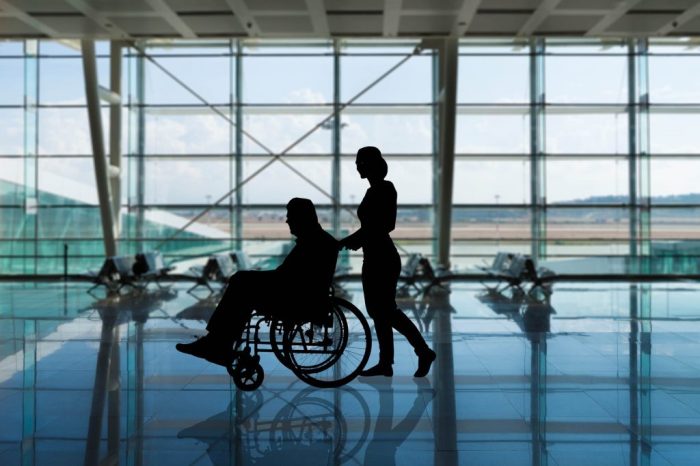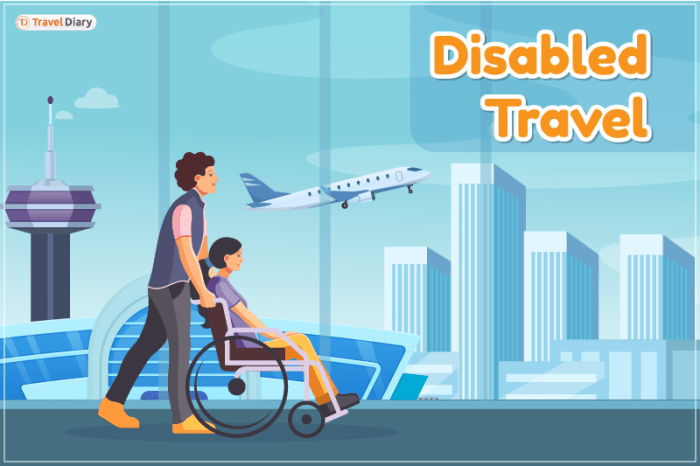
Travel tips for people with disabilities are crucial for ensuring a smooth and enjoyable travel experience. This guide provides comprehensive advice covering various aspects of accessible travel, from booking flights and accommodations to planning road trips and choosing budget-friendly options. We aim to empower individuals with disabilities to explore the world with confidence and independence, addressing the unique challenges and opportunities inherent in accessible travel planning.
We delve into detailed strategies for navigating airports and train stations, selecting accessible transportation, and finding suitable accommodations that cater to specific needs. We also explore less conventional travel options, such as accessible RV travel and unique accommodations, offering a diverse range of choices for those seeking adventure and relaxation. The information presented is designed to be practical and informative, empowering readers to plan their journeys with ease and assurance.
Accessible Air Travel
Planning air travel with a disability requires careful preparation and proactive communication with airlines. Understanding airline policies and procedures can significantly improve your travel experience and ensure a smoother journey. This section provides guidance on navigating the complexities of accessible air travel.
Booking Accessible Flights
Booking accessible flights involves several key steps. First, when searching for flights online, many airlines offer accessibility filters allowing you to specify your needs directly during the search. Look for options related to wheelchair assistance, in-flight mobility aids, or special meal requests. Once you’ve found a suitable flight, clearly indicate your accessibility requirements during the booking process. This usually involves selecting options within the booking form itself or contacting the airline directly through their customer service channels.
Be as specific as possible about your needs; for instance, specify the type of wheelchair you require (manual or motorized) and whether you need assistance with boarding and disembarking. Selecting seats with extra legroom is also advisable, offering more comfort and space for mobility aids or personal needs. Many airlines offer these seats for a small additional fee or may assign them based on your accessibility needs.
Packing for Air Travel with Mobility Aids
Efficient packing is crucial when traveling with mobility aids. Prioritize lightweight, durable equipment to minimize weight and strain. Consider using packing cubes to organize your belongings and keep your mobility aid parts separated. Always pack essential medications and any required medical documents in your carry-on bag. Remember to check airline regulations regarding the size and weight of both checked and carry-on baggage for mobility aids.
Some airlines may allow you to check your mobility aid free of charge, while others might have specific procedures or limitations. A well-organized packing strategy can reduce stress and streamline your journey. For example, packing frequently needed items in easily accessible locations in your carry-on baggage is vital.
Notifying Airlines About Specific Disability-Related Needs
Notifying airlines well in advance of your flight is essential. The general recommendation is to contact the airline at least 48 hours before departure, but it’s always best to contact them as soon as you book your flight. This allows the airline sufficient time to arrange the necessary assistance, including wheelchair assistance, special seating arrangements, and any other specific requirements you may have.
Keep a record of your communication with the airline, including confirmation numbers and any specific agreements made. This documentation can be invaluable should any unforeseen issues arise during your travel. Providing clear and detailed information about your specific needs will help the airline better accommodate you.
Airline Accessibility Policies
The following table compares the accessibility policies of some major airlines. Note that these policies are subject to change, so always verify the latest information directly with the airline before your flight.
| Airline | Wheelchair Assistance | Service Animal Policy | Special Meal Requests |
|---|---|---|---|
| Airline A | Provides assistance upon request; requires notification at least 48 hours prior. | Accepts service animals with appropriate documentation. | Offers a variety of special meal options; requires pre-ordering. |
| Airline B | Offers various levels of wheelchair assistance; notification recommended at booking. | Allows service animals in cabin; specific guidelines apply. | Special meals must be requested at least 24 hours before departure. |
| Airline C | Wheelchair assistance available; contact airline directly for details. | Service animals permitted with proper documentation and pre-approval. | Offers limited special meal options; must be requested during booking. |
| Airline D | Comprehensive wheelchair assistance program; requires pre-booking. | Detailed service animal policy available on their website. | Wide selection of special meals available with pre-order. |
Train Travel for Passengers with Disabilities
Planning a train journey with accessibility needs requires careful preparation. This section provides a comprehensive guide to help you navigate the process, from booking your ticket to arriving at your destination comfortably and safely. Understanding the available options and services will make your trip smoother and more enjoyable.
Reserving Accessible Train Tickets and Accommodations
Booking accessible train travel involves several key steps. First, contact the train company directly, either by phone or through their website. Many companies have dedicated accessibility departments or helplines. Clearly state your specific accessibility requirements, including the type and extent of assistance needed (e.g., wheelchair assistance, accessible restrooms, assistance with boarding). When booking online, look for options to specify accessibility needs during the booking process.
This often involves selecting an accessible seat or cabin. Confirm your booking details, including the type of assistance you’ve requested, before finalizing your purchase. Keep a record of your booking confirmation and any correspondence with the train company.
Types of Accessible Train Cars and Their Features
Accessible train cars vary depending on the train company and the age of the rolling stock. Generally, accessible cars feature wider aisles and doorways to accommodate wheelchairs and other mobility devices. These cars typically include designated wheelchair spaces with securement points for wheelchairs. Many modern trains also offer accessible restrooms with wider doorways and grab bars. Some trains may have priority seating areas near accessible entrances for passengers who may need to sit closer to the exits.
Features can include ramps or lifts for boarding, audio announcements, and visual displays to assist passengers with visual impairments. It’s advisable to check with the specific train company for details on the accessible features of the trains they operate on your route.
Assistance Services Offered by Train Companies
Most major train companies offer assistance services for passengers with disabilities. These services often include wheelchair assistance at stations, help with boarding and disembarking the train, and assistance with luggage. Some companies may also provide onboard assistance, such as help with finding your seat or accessing facilities. The level of assistance provided can vary, so it is crucial to contact the train company in advance to discuss your specific needs and arrange the necessary support.
Many companies also offer pre-boarding assistance, allowing passengers with disabilities to board the train before other passengers. This can reduce stress and make boarding easier.
Navigating Train Stations and Platforms with Mobility Devices
Navigating train stations and platforms with mobility devices requires careful planning and awareness. Before your journey, familiarize yourself with the station layout using the train company’s website or app, which often includes accessibility maps. Look for information on accessible entrances, elevators, ramps, and accessible restrooms. When possible, plan your route to minimize the distance you need to travel.
Be aware of potential obstacles, such as uneven surfaces or steps. If you need assistance, don’t hesitate to ask station staff for help. Many stations have staff dedicated to assisting passengers with disabilities. Consider using a personal locator beacon or similar device, especially if traveling alone.
Cruise Accessibility
Planning a cruise with a disability requires careful consideration, but with the right research and preparation, a memorable and accessible vacation is entirely achievable. Many cruise lines are increasingly committed to providing inclusive experiences, though the level of accessibility varies significantly. Understanding the nuances of each line’s offerings is key to selecting the best fit for your needs.
Accessible Cruise Cabins and Amenities
Cruise lines offer a range of accessible cabins, typically featuring features such as wider doorways, roll-in showers, grab bars, and lowered counters. However, the specific amenities and their quality differ considerably between cruise lines. For example, some lines might offer only a limited number of accessible cabins, while others dedicate a larger portion of their fleet to accessibility.
Reviews frequently highlight the importance of booking well in advance to secure an accessible cabin, as these are often in high demand. Some reviews praise specific lines for their spacious and well-designed accessible cabins, including features such as adjustable beds and emergency call buttons. Others mention inconsistencies in the quality of maintenance and upkeep of these cabins across different ships within the same fleet.
It’s crucial to read detailed reviews focusing on accessibility from various sources before making a booking.
Embarkation and Disembarkation for Passengers with Disabilities
The embarkation and disembarkation processes can be simplified significantly with prior communication and planning. Most cruise lines provide assistance services for passengers with disabilities, but contacting them well in advance is vital to arrange necessary support, such as wheelchair assistance, priority boarding, and specialized transportation. This includes coordinating with the cruise line to arrange for accessible transportation from the airport to the port.
Disembarkation also requires similar pre-planning to ensure a smooth and stress-free experience. Passengers should confirm the availability of accessible transportation from the ship to their next destination. Failure to pre-arrange these services can lead to significant delays and inconvenience.
Tips for Making the Most of a Cruise While Using Mobility Aids
Before embarking on a cruise, it is essential to carefully review the ship’s accessibility features and plan your itinerary accordingly. Consider the location of accessible amenities, such as elevators, restaurants, and restrooms, to optimize your movement throughout the ship. Communicating your mobility needs to the cruise line staff ensures they can provide the necessary assistance and support. Packing appropriate mobility aids and any required medical supplies is crucial.
This includes ensuring your mobility aid is compatible with the ship’s environment and having backup plans in case of malfunctions. Familiarize yourself with the ship’s layout and accessibility features using available online resources or contacting the cruise line’s accessibility department. Take advantage of the cruise line’s assistance services and don’t hesitate to ask for help when needed.
Remember to allow extra time for travel between destinations on the ship and shore excursions.
Road Trip Planning for Accessible Travel

Embarking on a road trip offers unparalleled freedom and flexibility, but careful planning is crucial for travelers with disabilities to ensure a smooth and enjoyable journey. This section details key considerations for accessible road trip planning, covering vehicle preparation, rental options, roadside assistance, and route optimization.
Vehicle Preparation Checklist
Preparing your vehicle is paramount for a successful accessible road trip. Overlooking even minor details can significantly impact comfort and safety. The following checklist helps ensure your vehicle is properly equipped.
- Wheelchair Securement: Verify that any necessary wheelchair securing devices are in place and properly functioning. This might include ramps, tie-downs, or lifts, depending on the type of wheelchair and vehicle.
- Adaptive Equipment: Install or confirm the presence of any required adaptive equipment, such as hand controls, spinner knobs, or specialized pedals. Ensure they are correctly adjusted for the driver.
- Emergency Kit: Pack a comprehensive emergency kit including a first-aid kit, tire-changing tools, jumper cables, flares, and a fully charged cell phone with a car charger.
- Accessibility Features Check: Confirm that the vehicle’s accessibility features, such as automatic doors, ramps, or lift systems, are working correctly. Test these features before departure.
- Space and Storage: Ensure there is sufficient space for luggage, mobility devices, and any other necessary equipment. Proper storage prevents items from becoming hazards during travel.
- Comfort Items: Include cushions, blankets, and other comfort items to make the journey more comfortable for the passenger with a disability. This might include items to support posture or reduce pressure points.
Accessible Rental Car Options and Modifications
Several rental car companies offer accessible vehicles, although availability can vary significantly by location and vehicle type. These vehicles may include features like ramps, hand controls, and lowered floors. For more extensive modifications, independent modification specialists can adapt vehicles to individual needs, often fitting specialized lifts or other adaptive equipment. Contacting rental companies in advance and specifying accessibility requirements is crucial for securing a suitable vehicle.
Accessible Roadside Assistance Services
Many roadside assistance providers offer specialized services for individuals with disabilities. These services might include assistance with wheelchair transfers, securing a disabled vehicle, and arranging alternative transportation. It is advisable to research and select a provider with a demonstrated commitment to accessibility and to inform them of your specific needs when arranging coverage.
Route Planning for Minimizing Barriers
Planning a route that minimizes barriers for wheelchair users or individuals with other mobility challenges requires careful consideration. Utilize online mapping tools that provide information on accessibility features at potential stops, such as restaurants, restrooms, and lodging. Look for routes that avoid steep inclines, narrow walkways, and areas with uneven surfaces. Consider using accessible route planners specifically designed for individuals with disabilities, which may highlight accessible facilities and transportation options along your route.
Pre-booking accommodations and confirming accessibility features is essential to prevent unexpected disruptions.
Budget-Friendly Accommodation Options: Travel Tips For People With Disabilities
Finding affordable and accessible accommodation can significantly impact the overall cost and enjoyment of your trip. Many resources and strategies exist to help travelers with disabilities locate budget-friendly options without compromising comfort or accessibility. This section explores websites, tips, and negotiation strategies, along with a comparison of various affordable accommodation types.
Websites and Resources for Accessible Accommodations, Travel tips for people with disabilities
Several websites specialize in listing accessible accommodations. These platforms often allow filtering by accessibility features, price range, and location, simplifying the search process. Using these resources can save significant time and effort compared to manually searching individual hotel websites. Some notable examples include AccessibleGo, Accessible Travel, and Wheel the World, although many other smaller, regional options exist.
It’s advisable to check reviews and compare prices across multiple platforms before booking.
Tips for Finding Affordable Accessible Hotels and Vacation Rentals
Finding affordable accessible accommodations requires strategic planning and research. Consider traveling during the off-season or shoulder season to benefit from lower prices. Weekday stays are often cheaper than weekend stays. Booking well in advance, particularly for popular destinations, can sometimes secure better rates. Utilizing flexible date options can also uncover unexpected savings.
Furthermore, exploring options outside major city centers may reveal more affordable accessible accommodations. Vacation rentals, such as those listed on Airbnb or VRBO, can sometimes offer more space and accessibility features at a lower cost than hotels, but always carefully verify accessibility details with the host beforehand.
Strategies for Negotiating Lower Rates for Accessible Rooms
Negotiating lower rates for accessible rooms is possible, particularly when booking directly with hotels or smaller establishments. Politely explain your needs and your budget constraints. Mentioning loyalty programs or memberships to travel organizations can also strengthen your negotiating position. Highlighting your intention to stay for an extended period can sometimes sway the hotel to offer a discount.
Be prepared to present alternative dates or room types if the initial offer isn’t suitable. Remember to be respectful and professional throughout the negotiation process.
Comparison of Budget-Friendly Accommodation Types
| Accommodation Type | Approximate Cost Range (USD/night) | Accessibility Features | Pros | Cons |
|---|---|---|---|---|
| Budget Hotel (Chain) | $50 – $150 | May offer ADA-compliant rooms; features vary widely | Wide availability, consistent quality (generally) | Limited space, may lack specific accessibility features |
| Budget Hotel (Independent) | $40 – $120 | Accessibility varies greatly; requires careful verification | Potentially more character, may offer personalized service | Inconsistent quality, accessibility features may be limited or unavailable |
| Vacation Rental (Airbnb/VRBO) | $60 – $200+ | Accessibility varies greatly; requires careful verification with host | More space, kitchen facilities, potentially more privacy | Accessibility features are not guaranteed; relies on host’s accuracy and responsiveness |
| Hostels (Select locations) | $25 – $75 | Accessibility varies widely; some hostels offer accessible rooms | Very affordable, social environment | Shared facilities, may not offer private accessible bathrooms |
Finding and Booking Accessible Vacation Rentals
Securing accessible vacation rentals requires careful planning and research. Numerous platforms offer listings, but verifying accessibility features is crucial to ensure a comfortable and enjoyable trip. This section Artikels strategies for finding and booking suitable accommodations.Finding accessible vacation rentals involves utilizing specialized search filters and carefully reviewing property descriptions. Many popular platforms like Airbnb allow users to filter search results based on accessibility features.
However, the accuracy and detail of these features can vary greatly, emphasizing the need for thorough verification.
Searching for Accessible Vacation Rentals on Online Platforms
Utilizing online platforms like Airbnb, VRBO, and Booking.com offers a wide selection of vacation rentals. Effective searches involve using specific s related to accessibility needs, such as “wheelchair accessible,” “roll-in shower,” “wide doorways,” and “accessible parking.” Many platforms now include accessibility filters directly in their search functions, making it easier to narrow down results. It’s advisable to check multiple platforms to broaden the search and compare options.
Verifying Accessibility Features Before Booking
Before committing to a booking, meticulously examine the property’s description and photographs. Pay close attention to details regarding bathroom accessibility (roll-in showers, grab bars, toilet height), bedroom accessibility (sufficient space for maneuvering wheelchairs or other mobility devices), and overall accessibility of the living areas. Look for high-quality photos showcasing the relevant features; blurry or missing images should raise concerns.
Reading reviews from previous guests who have similar accessibility needs can provide invaluable insights into the property’s true accessibility.
Questions to Ask Property Owners to Ensure Accessibility
To gain a clearer picture of accessibility, directly contacting the property owner is essential. The following questions can help clarify any ambiguities or uncertainties about the property’s features:
- What is the width of the doorways throughout the property?
- Are there any steps or thresholds leading into the property or any rooms?
- Does the bathroom include a roll-in shower or a shower with a shower chair?
- Is there grab bar support in the bathroom and near the shower/tub?
- What is the height of the toilet?
- Is there adequate space to maneuver a wheelchair or other mobility device throughout the property?
- Is there accessible parking available on the property or nearby?
- Are there any other accessibility features, such as ramps or elevators?
- Can you provide additional photographs or videos showcasing the accessibility features?
Thorough communication helps manage expectations and avoid potential issues. Requesting detailed information and visual aids before booking reduces the risk of unforeseen accessibility problems during the vacation.
Examples of Detailed Descriptions for Accessible Vacation Rentals
A well-written description should clearly and concisely detail the property’s accessibility features. Here are examples:
Example 1: “This beautiful beachfront condo offers complete accessibility for wheelchair users. Features include a ramped entry, wide doorways (36 inches minimum), a roll-in shower with a built-in seat and grab bars, a lowered sink and toilet, and ample space for wheelchair maneuvering throughout the unit. Designated accessible parking is available directly in front of the building.”
Example 2: “Our charming cottage is designed for guests with mobility challenges. The single-story layout eliminates stairs, and all doorways are 32 inches wide. The bathroom features a walk-in shower with a hand-held showerhead and grab bars. While there is no elevator, the property is on one level. A designated parking space is available just outside the front door.”
These detailed descriptions provide potential renters with the information necessary to determine if the property meets their accessibility requirements. Remember, accurate and transparent descriptions are essential for building trust and ensuring a positive rental experience.
Hotel Accessibility Reviews and Recommendations

Choosing an accessible hotel requires careful consideration beyond just the hotel’s claims. Online reviews offer invaluable insights into the reality of accessibility at a given property. Learning to effectively interpret these reviews can significantly improve your travel experience.Reading and interpreting hotel accessibility reviews requires a critical eye. Don’t rely solely on positive comments; look for specific details and corroborating evidence.
Pay close attention to the reviewer’s stated disability, as the challenges faced can vary widely. For example, a review focusing on wheelchair accessibility won’t necessarily address the needs of someone with visual impairments.
Identifying Potential Accessibility Issues from Reviews and Photos
Online reviews frequently mention specific accessibility features or lack thereof. Look for s such as “wheelchair ramp,” “roll-in shower,” “grab bars,” “accessible room,” “elevator,” “wide doorways,” and “accessible parking.” Negative reviews often highlight issues like poorly maintained ramps, non-functional elevators, or rooms that don’t meet advertised accessibility standards. Pay attention to the reviewer’s descriptions of their experiences navigating the hotel.
Were there unexpected obstacles? Did the hotel staff respond effectively to accessibility concerns?Accompanying photos can provide visual confirmation of what reviewers describe. Check for images that clearly show the width of doorways, the condition of ramps, the size of bathrooms, and the layout of accessible rooms. A photo of a ramp with a steep incline or a bathroom with limited space would indicate potential problems.
Remember, however, that photos might not always capture every detail.
Examples of Detailed and Helpful Accessibility Reviews
A helpful review might read: “As a wheelchair user, I found this hotel to be mostly accessible. The ramp to the entrance was a bit steep, but manageable. My room had a spacious roll-in shower with grab bars, and the doorway was wide enough for my chair. However, the elevator was quite slow, and the restaurant’s tables were a bit crowded.” This provides specific information that allows other travelers with similar needs to assess whether the hotel is suitable for them.
Conversely, a less helpful review might simply say “accessible room, good hotel.” This lacks detail and doesn’t help travelers understand the specifics of the accessibility features.
Questions to Ask Hotel Staff About Accessibility Features
Before booking, contacting the hotel directly is crucial. While online reviews are helpful, direct communication allows you to clarify specific concerns and ensure the hotel can meet your needs. Instead of relying solely on generic descriptions, inquire about the specific dimensions of doorways, the type of shower (roll-in or standard), the availability of assistive devices, and the location of accessible parking.
Confirm the availability of accessible rooms, and if possible, request photos of the room’s accessibility features. Asking about staff training in assisting guests with disabilities is also vital. Inquiring about the accessibility of common areas, such as restaurants and pools, is equally important. Finally, clarifying the hotel’s policy on service animals is essential.
RV and Campervan Travel for People with Disabilities
RV and campervan travel offers a unique blend of freedom and flexibility, making it an appealing option for many. However, for individuals with disabilities, careful planning and consideration are crucial to ensure a safe and enjoyable experience. This section explores the advantages and challenges of RV travel for people with disabilities, providing practical guidance on modifications, planning, and the acquisition process.
Advantages and Challenges of RV Travel for People with Disabilities
RV travel can provide significant advantages for people with disabilities. The self-contained nature of an RV eliminates many of the accessibility challenges encountered in hotels or other forms of accommodation. Travelers can control their environment, schedule, and pace, minimizing potential stressors associated with navigating unfamiliar environments. Furthermore, RVs allow for greater independence and control over personal care routines.
However, challenges exist. Finding accessible RVs and campsites can be difficult, and modifications can be expensive. Navigating uneven terrain and managing equipment within a confined space may also present difficulties depending on the individual’s specific needs. Careful planning and preparation are essential to mitigate these challenges and maximize the benefits.
Accessible RV and Campervan Modifications
Numerous modifications can enhance the accessibility of RVs and campervans. These range from simple additions to extensive renovations. Examples include: lowered entry steps or ramps for wheelchair users; wider doorways and hallways to accommodate wheelchairs and mobility aids; adjustable countertops and sinks to accommodate varying heights; grab bars in bathrooms and showers; wheelchair-accessible showers and toilets; specialized seating and sleeping arrangements; lift systems for wheelchairs; and automated lighting and appliance controls.
The specific modifications required will depend on the individual’s needs and the type of RV or campervan. Professional RV modification companies specialize in creating custom solutions to meet diverse accessibility requirements. For example, a company might install a ramp system that seamlessly integrates with the RV’s existing design, or they might retrofit a bathroom to include a roll-in shower and grab bars.
Planning Accessible RV Campsites and Routes
Careful planning is essential for accessible RV travel. Before embarking on a trip, it’s crucial to research campsites and routes to ensure accessibility. Many campgrounds advertise accessibility features, but it’s always advisable to contact them directly to confirm the availability and suitability of these features. Look for campsites with level, paved sites, accessible restrooms and showers, and ample space for maneuvering a vehicle and mobility aids.
When planning routes, consider the condition of roads and potential obstacles such as steep inclines or uneven surfaces. GPS navigation systems with accessibility features can be helpful in identifying potential challenges and finding alternative routes. For example, using a navigation app that highlights accessible routes and amenities allows for proactive planning and avoidance of unexpected difficulties. Apps that provide detailed information on campsite accessibility features, such as paved pathways and accessible restrooms, can be extremely useful.
Renting or Purchasing an Accessible RV or Campervan
Individuals can either rent or purchase an accessible RV or campervan. Renting offers a cost-effective way to try out RV travel before committing to a purchase. Several rental companies specialize in providing accessible RVs, but availability may be limited. Purchasing an accessible RV allows for greater customization and long-term cost savings, but it represents a significant financial investment.
When purchasing, it’s crucial to carefully assess the RV’s accessibility features and ensure they meet the individual’s specific needs. Working with a reputable dealer or modification company can help ensure the RV is properly equipped and meets safety standards. Financing options may be available through specialized lenders who understand the unique needs of people with disabilities. Thorough research and careful planning are essential to finding the best option for individual circumstances and financial capabilities.
Ultimately, accessible travel is about more than just physical access; it’s about creating opportunities for everyone to experience the joy of exploration and discovery. By understanding the available resources, planning ahead, and advocating for inclusive travel practices, individuals with disabilities can overcome barriers and embrace the transformative power of travel. We hope this guide has provided valuable insights and tools to make your next adventure both accessible and unforgettable.
Questions and Answers
What are some common accessibility issues travelers with disabilities face?
Common issues include inaccessible transportation, lack of appropriate accommodations, inadequate assistance at airports and train stations, and poorly designed routes or attractions.
How can I find out if a hotel is truly accessible?
Call the hotel directly and ask specific questions about room features, accessibility of common areas, and available assistance. Check online reviews for detailed accounts of accessibility from other travelers.
What documentation should I bring when traveling with a disability?
Bring necessary medical documentation, a copy of your itinerary, and contact information for your airline, hotel, and any support services you’ll be using.
What if I encounter accessibility problems during my trip?
Document the issue (photos, notes) and immediately contact the relevant service provider (airline, hotel, etc.) to report the problem. If necessary, seek assistance from disability advocacy groups or travel agencies.





